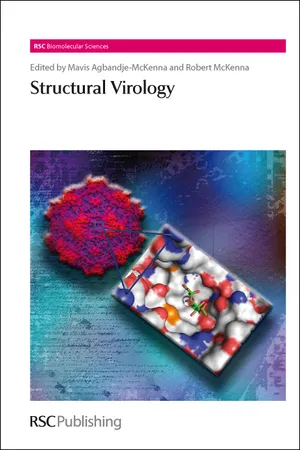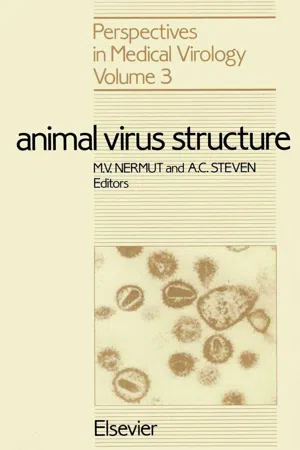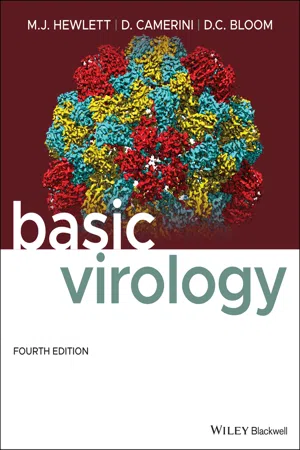Biological Sciences
Viral Structure
Viral structure refers to the physical makeup of a virus, which typically consists of genetic material (DNA or RNA) enclosed in a protein coat called a capsid. Some viruses also have an outer lipid envelope. The structure of a virus is essential for its ability to infect host cells and replicate.
Written by Perlego with AI-assistance
Related key terms
1 of 5
9 Key excerpts on "Viral Structure"
- eBook - PDF
- Mavis Agbandje-McKenna, Robert McKenna(Authors)
- 2010(Publication Date)
- Royal Society of Chemistry(Publisher)
This monograph will discuss viruses assembled from the simplest of icosahedral capsids, with T ¼ 1 triangulation (assembled from 60 CP/VP subunits), to those with more complicated VP shells assembles and lipid membrane envelopes. Viruses have been responsible for more human deaths, either through direct infection (such as influenza virus) or infection of crops, than any other known human disease-causing agent. In addition, their ability to package efficiently and deliver genomic material to different living organisms and tissues also makes them attractive vehicles for the delivery of therapeutic genetic material in situations where defective genes lead to disease phenotypes. Thus viruses are the subject of intense scientific study in many different disciplines, including structure biology, in efforts to (i) understand the basic biological processes governing viral infection and (ii) develop treatment strategies, including vac-cines, anti-virals and gene delivery vectors. The use of structure approaches in virology has given insight into the structural basis of assembly, nucleic acid packaging, particle dynamics and interactions with cellular molecules and allowed the elucidation of mechanistic pathways at the atomic and molecular level. Biological processes, such as the life cycle of a virus infection, are governed by numerous intricate macro-molecular interactions. The role of the structural virologist is thus to visualize these interactions in three dimensions (3D), to provide a full understanding of these interactions as ‘seeing is believing’. These structural characterizations of viruses then provide crucial platforms for the development of treatment and therapeutic strategies (Section 3 of this monograph). The range of biophysical methods used in structural virology is vast, ranging from hydrodynamic to scattering techniques (Section 1 of this monograph), and have played a fundamental role in our understanding of viral infection in recent years. - eBook - PDF
- M.V. Nermut, A.C. Steven(Authors)
- 1987(Publication Date)
- Elsevier Science(Publisher)
PART I General principles of virus architecture This Page Intentionally Left Blank Nermut/Steven (eds) Animal Virus Structure 0 1987 Elsevier Science Publishers B.V. (Biomedical Division) 3 CHAPTER 1 General principles of virus architecture M.V. NERMUT National Institute for Medical Research, London NW7, U. K. 1.1. Introduction A comprehensive definition of viruses should take into account not only their physical and chemical properties, but also their biological and pathological ’ aspects. In this chapter on the structure of viruses we shall refrain from an attempt at a comprehensive definition and will restrict ourselves to the statement that ‘viruses are organized associations of macromolecules’. This physical-chemical concept of viruses provides a basis for understanding the principles of virus ar- chitecture and the mechanisms of virus assembly. However, we should make it clear that there is no unique morphological entity - the virion - but a great variety of architectural solutions to the fundamental principle of viral pathogenesis: the transfer of viral genome from cell to cell. Nevertheless, there are certain common features and general principles in virus architecture and these will be discussed in this chapter. The architecture of a virus is specified primarily by the properties of its consti- tuent macromolecules. They form the ‘basic structural elements’ of the virion, i.e. the morphological entities, that are often observable in the electron microscope (e.g. capsomers, spikes). These usually associate into ‘structural complexes’ form- ed by two or more different types of ‘basic structural elements’, e.g. an envelope is formed by a lipid bilayer and the glycoprotein spikes, a virus core consists of a core shell and a nucleoprotein complex, more complex viruses comprise a nucleocapsid, core shell and envelope or capsid, etc. - eBook - ePub
- Martinez J. Hewlett, David Camerini, David C. Bloom(Authors)
- 2021(Publication Date)
- Wiley-Blackwell(Publisher)
PART II Basic Properties of Viruses and Virus–Cell Interaction- Virus Structure and Classification
- The Features of a Virus
- Classification Schemes
- The Virosphere
- The Human Virome
- The Beginning and End of the Virus Replication Cycle
- Outline of the Virus Replication Cycle
- Viral Entry
- Late Events in Viral Infection: Capsid Assembly and Virion Release
- The Innate Immune Response: Early Defense Against Pathogens
- Host Cell-Based Defenses Against Virus Replication
- The Adaptive Immune Response and the Lymphatic System
- Control and Dysfunction of Immunity
- Measurement of the Immune Reaction
- Strategies to Protect Against and Combat Viral Infection
- Vaccination – Induction of Immunity to Prevent Virus Infection
- Eukaryotic Cell-Based Defenses Against Virus Replication
- Antiviral Drugs
- Bacterial Antiviral Systems – Restriction Endonucleases
- Problems for Part II
- Additional Reading for Part II
Passage contains an image
CHAPTER 5 Virus Structure and Classification
- THE FEATURES OF A VIRUS
- Viral genomes
- Viral capsids
- Viral envelopes
- CLASSIFICATION SCHEMES
- The Baltimore scheme of virus classification
- Disease‐based classification schemes for viruses
- THE VIROSPHERE
- QUESTIONS FOR CHAPTER 5
THE FEATURES OF A VIRUS
Viruses are small compared to the wavelength of visible light; indeed, while the largest virus can be discerned in a good light microscope, the vast majority of viruses can only be visualized in detail using an electron microscope. A size scale with some important landmarks is shown in Figure 5.1 .Virus particles are composed of a nucleic acid genome or core, which is the genetic material of the virus, surrounded by a capsid made up of virus‐encoded proteins. Viral genetic material encodes the structural proteins of the capsid and other viral proteins essential for other functions in initiating virus replication. The entire structure of the virus (the genome, the capsid, and – where present – the envelope) makes up the virion or virus particle. The exterior of this virion contains proteins that interact with specific proteins on the surface of the cell in which the virus replicates. The schematic structures of some well‐characterized viruses are shown in Figure 5.2 - eBook - ePub
- Boriana Marintcheva(Author)
- 2017(Publication Date)
- Academic Press(Publisher)
Chapter 1Introduction to Viral Structure, Diversity and Biology∗
Abstract
Welcome to the diverse and exciting world of viruses. This chapter will introduce you to Viral Structure and biology on the level of the big picture with the goal to allow sufficient background to meaningfully explore the rest of the book. The chapter introduces concepts of viral biology on the example of prokaryotic viruses and highlights key differences between them, animal, and plant viruses. Examples of limited number of classical viral systems (T4, T7, herpes simplex virus type 1, HIV, influenza, tobacco mosaic virus) are used to illustrate science principles underlying the fascinating world of viruses. Viral diversity is discussed in the context of the current viral classification and evolution. Key characteristics of virus–host interactions on the cellular level and examples of viral “tricks” employed to direct cellular machinery toward fulfilling viral goals are explored.Keywords
Latency; Viral life cycles; Viral plaque; Virus evolution; Virus structureTiny, deadly, fascinating. Viruses have been around us for thousands of years and have impacted our society regardless how well we understood them. It is hard to imagine that when the word virus is mentioned, something positive will come to mind. After all, viruses got their name from the Latin word for poison, which fits them perfectly when picturing the devastating diseases they cause in humans, animals, and plants. When computers came around and self-replicating programs became the fact of life, the term virus gained a new meaning: again not exactly a positive one. Not that long time ago the Internet brought to us the idea of viral videos. Today we can describe as viral not only meningitis (hoping that we will never need to deal with one) but also anything funny, crazy, amazing, or spectacular caught on video. Now thanks to “YouTube”, the idea of Latin word for poison being associated with something different from disaster does not sound absolutely outrageous, does it? - eBook - PDF
- Edward K. Wagner, Martinez J. Hewlett, David C. Bloom, David Camerini(Authors)
- 2009(Publication Date)
- Wiley-Blackwell(Publisher)
P A R T II Basic Properties of Viruses and Virus–Cell Interaction ✷ Virus Structure and Classification ✷ The Features of a Virus ✷ Classification Schemes ✷ The Virosphere ✷ The Beginning and End of the Virus Replication Cycle ✷ Viral Entry ✷ Late Events in Viral Infection: Capsid Assembly and Virion Release ✷ Host Immune Response to Viral Infection – The Nature of the Vertebrate Immune Response ✷ The Innate Immune Response – Early Defense Against Pathogens ✷ The Adaptive Immune Response and the Lymphatic System ✷ Control and Dysfunction of Immunity ✷ Measurement of the Immune Reaction ✷ Strategies to Protect Against and Combat Viral Infection ✷ Vaccination – Induction of Immunity to Prevent Virus Infection ✷ Eukaryotic Cell-based Defenses Against Virus Replication ✷ Antiviral Drugs ✷ Bacterial Antiviral Systems – Restriction Endonucleases ✷ Problems for Part II ✷ Additional Reading for Part II Virus Structure and Classification C H A P T E R 5 ✷ THE FEATURES OF A VIRUS ✷ Viral genomes ✷ Viral capsids ✷ Viral envelopes ✷ CLASSIFICATION SCHEMES ✷ The Baltimore scheme of virus classification ✷ Disease-based classification schemes for viruses ✷ THE VIROSPHERE ✷ QUESTIONS FOR CHAPTER 5 THE FEATURES OF A VIRUS Viruses are small compared to the wavelength of visible light; indeed, while the largest virus can be discerned in a good light microscope, the vast majority of viruses can only be visualized in detail using an electron microscope. A size scale with some important landmarks is shown in Fig. 5.1. Virus particles are composed of a nucleic acid genome or core, which is the genetic material of the virus, surrounded by a capsid made up of virus-encoded proteins. Viral genetic material encodes the structural proteins of the capsid and other viral proteins essential for other functions in initiating virus replication. The entire structure of the virus (the genome, the capsid, and – where present – the envelope) make up the virion or virus particle. - eBook - PDF
Virology
Principles and Applications
- John Carter, Venetia Saunders(Authors)
- 2014(Publication Date)
- Wiley(Publisher)
J. et al. (2009) Chapters 3 and 4 in Principles of Virology, Volume 1, 3rd edition, ASM Press Harrison, S. C. (2007) Principles of virus structure. Chapter 3 in Fields Virology, 5th edition (Knipe D. M. and Howley, P. M., editors-in-chief), Lippincott, Williams and Wilkins Historical paper Caspar, D. L. D. and Klug, A. (1962) Physical principles in the construction of regular viruses. Cold Spring Harbor Symposia Quantitative Biology, 27, 1–24 Recent papers Amos, L. A. and Finch, J. T. (2004) Aaron Klug and the revolution in biomolecular structure determination. Trends In Cell Biology, 14, 148–152 44 CHAPTER 3 VIRUS STRUCTURE Clare, D. K. and Orlova, E. V. (2010) 4.6 Å Cryo-EM reconstruction of tobacco mosaic virus from images recorded at 300 keV on a 4k 3 4k CCD camera. Journal of Structural Biology, 171, 303–308 Huiskonen, J. H. and Butcher, S. J. (2007) Membrane-containing viruses with icosahedrally symmetric capsids. Current Opinion in Structural Biology, 17, 229–236 Rey, F. A. (2010) Virology: one protein, many functions. Nature, 468, 773–775 Ruigrok, R. W. H., Crépin, T., and Kolakofsky, D. (2011) Nucleoproteins and nucleocapsids of negative-strand RNA viruses. Current Opinion in Microbiology, 14, 504–510 Schneemann, A. (2006) The structural and functional role of RNA in icosahedral virus assembly. Annual Review of Microbiology, 60, 51–67 Shepherd, C. M. et al. (2006) VIPERdb: a relational database for structural virology. Nucleic Acids Research, 34 (Database Issue), D386–D389 - eBook - PDF
- Rodney P. Anderson, Linda Young, Kim R. Finer(Authors)
- 2020(Publication Date)
- Wiley(Publisher)
The structures of the tail region are used for host attachment. These viruses are often bacteriophages, or viruses capable of infecting bacteria. Some viruses are also surrounded by an envelope that forms from pieces of host cell membrane as the virus is released. The envelope helps protect the virus from the host immune system. However, enveloped viruses are more easily destroyed during sterilization processes because their mem- brane coating is damaged by heat, detergents, and drying. The presence or absence of an envelope influences the entry and exit strategies a virus uses to infect a host cell. Viruses that lack an envelope are described as naked viruses. Protein or glycoprotein spikes project from either the nucleocapsid or bacteriophage A virus that infects bacterial cells; also known as a phage. 172 CHAPTER 8 Viruses and Infectious Particles classify more than 5000 different viruses based on similarity in genetic makeup, chemical composition, replication method, and overall structure. Members of the same viral species must also share a common genome and the ability to infect the same hosts, or host range. Using these criteria, the full ICTV clas- sification of the virus that causes AIDS is family: Retroviridae; genus: Lentivirus; species: human immunodeficiency virus (HIV). Figure 8.2 provides examples of important viruses in each family along with the infections they cause. Visual rep- resentations of their external morphology and/or internal structures help distinguish among these diverse pathogens. To highlight their distinctive features, the viruses are ini- tially grouped by genome composition: RNA (Figure 8.2a) or DNA (Figure 8.2b). Single-stranded RNA viruses are subdivided into (+) sense or (−) sense genomes. These RNA viruses can be compared to the double-stranded RNA the envelope and function in the attachment of the virus to the host cell. - eBook - PDF
Viruses
Biology, Applications, and Control
- David Harper(Author)
- 2011(Publication Date)
- Garland Science(Publisher)
The core complex of nucleic acid packaged with structural and replicative pro-teins is called the nucleocapsid . • Specific receptors/effectors on the virion surface that allow the virus to bind to and enter the target cell. These are often complexes of protein and sugars ( glycoproteins ) and may be contained in an envelope de-rived from host cell lipid. These requirements are fulfilled in very different ways by different viruses. The complexity of a virus is a direct reflection of the size of the viral genome. The more information a virus can encode, the more proteins it can make. mRNA = Nucleocapsid = Virus Nucleus mRNA Viral genome Genome replicated Early ( regulatory ) proteins Late ( structural ) proteins ASSEMBLY Figure 1.1 Schematic diagram of virus replication. Virus particles (virions) attach to target cells and gain entry. The viral genome (purple) is transcribed into mRNA (green) and is also replicated. The early proteins (red) translated from viral mRNA often have a regulatory function, while those produced later have a structural role. Viral proteins and nucleic acids are assembled into progeny viral particles, which are released from the cell. CHAPTER 1 Virus Structure and Infection 5 Viruses infecting humans produce anything from one to more than a hun-dred proteins. Viruses come in a range of shapes and sizes (morphologies). The viral genome can be either DNA (as with all cellular life) or (uniquely to viruses) RNA. Virions do not contain both types of nucleic acid. An RNA genome, while relatively common among viruses, has many implications for the virus, discussed in Chapter 3. 1.2 VIRUS STRUCTURE AND MORPHOLOGY Capsids The capsid is the protein structure surrounding the viral genome and is formed of repeating protein subunits ( capsomers ) assembled around the nucleic acid to form the nucleocapsid. The use of small protein subunits reduces the amount of genetic coding capacity that has to be dedicated to producing the capsid proteins. - eBook - PDF
- Karl Maramorosch(Author)
- 2012(Publication Date)
- Academic Press(Publisher)
IV. Physical, Biological and Chemical Characteristics This page intentionally left blank THE STRUCTURE AND PHYSICAL CHARACTERISTICS OF BACULOVIRUSES D. C. KELLY Natural Environment Research Council Institute of Virology Mansfield Road> Oxford Baculoviruses are large structurally complex viruses. Their very complexity has long intrigued electron microscopists and most evidence concerning the structure of the viruses de-rives from electron microscope studies. Other biophysical techniques have been applied to study baculovirus architecture and, in some instances, these approaches have proved signifi-cant insights into the structural organization of the viruses. Baculovirus particles are, in most cases, packaged into large protein crystals variously termed as polyhedra, capsules, granules, whole inclusion bodies or polyhedral inclusion bodies. The occlusion or packaging of virus particles ap-pears to be a genetically defined trait with some virus types containing just one virus particle per crystal whereas other types package many virus particles within a protein crystal. Baculoviruses have been classified according to their structure into nuclear polyhedrosis viruses, granulosis viruses, and nonoccluded baculoviruses (Matthews, 1982). Non-occluded baculoviruses, typified by a baculovirus from Oryctes rhinoceros (Payne, 1974) fail to synthesize polyhedra (Huger, 1966; Kelly, 1975) and, consequently, never become packaged in protein crystals. Granulosis viruses (GVs) typically com-prise small crystals (capsules or granules—hence the term granulosis) containing a solitary virus particle. Nuclear polyhedrosis viruses (NPVs), on the other hand, contain numer-ous virus particles within a given polyhedron. They take VIRAL INSECTICIDES Copyright © 1985 by Academic Press, Inc. FOR BIOLOGICAL CONTROL 4 6 9 All rights of reproduction in any form reserved. ISBN 0-12-470295-3 470 D. C. KELLY their name from the presence of polyhedra in an infected cell nucleus.
Index pages curate the most relevant extracts from our library of academic textbooks. They’ve been created using an in-house natural language model (NLM), each adding context and meaning to key research topics.








